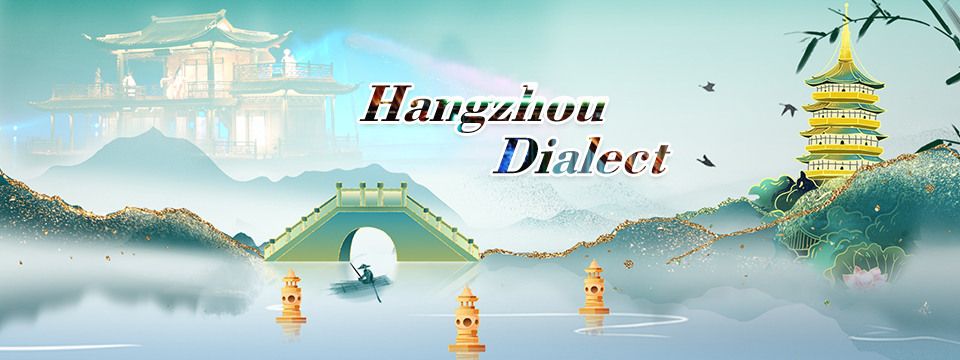About Hangzhou Dialect
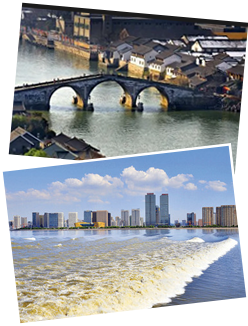
Hangzhou dialect refers to the local dialect spoken in Hangzhou and some of its suburbs. It is different from other dialects spoken in the greater Hangzhou area. Hangzhou dialect is also known as Jiangnan official dialect because of its location in the south of the Yangtze River and its relative proximity to the northern official dialects. It is not only for geographical reasons that Hangzhou dialect is classified as a small part of Wu language, but also because the language itself has the basic characteristics of Wu language, although several waves of migration from the north, represented by the southward relocation of the ruling centre of Song dynasty, have caused the local language system to undergo great changes and gradually take on a special character in Jiangnan region.
Hangzhou is the largest city in Zhejiang Province, but Hangzhou dialect is one of the smallest dialects of Wu languages in Zhejiang. Conservative estimates put the population of native speakers of Hangzhou dialect in China at between 1.2 million and 1.5 million. Hangzhou dialect is spoken in a small area, roughly from Yuhang and Xiasha in the east to Qiantang River in the south, from Wuyun Mountain and Zhuantang to Liuxia in the west, from Gongchen Bridge to Sanduan in Yuhang in the north, and between Jianqiao to Qiaosi in Yuhang in the northeast. Once an official language, Hangzhou dialect is the result of the intermingling of the official languages of Tang and Song dynasties with Wu and Yue dialects, and is a representative of the official languages of Jiangnan after the Northern Song dynasty.
Historical Development of Hangzhou Dialect
-

Before Jin Dynasty (266-420)
During the Spring and Autumn Period, when Wu and Yue were fighting for supremacy, Hangzhou belonged first to Yue and then to Wu, and after Yue defeated Wu, it reverted back to Yue. Therefore, Hangzhou dialect of that time belonged to the ancient Wu language. Wu language was born from a gradual fusion of the language spoken by the nobles of Wu State and that of the local Yue inhabitants, who were not yet part of Han nationality, when King Tai Bo of Wu moved to Wu in Zhou Dynasty. Hangzhou dialect did not undergo large-scale changes during Qin, Han and Three Kingdoms Period. It was not until Yongjia period of the Western Jin Dynasty (307-311) when Han Chinese from the north moved southwards in large numbers that the first changes to the Hangzhou dialect began.
-

Southward Migration in Yongjia Period of the Western Jin Dynasty (307-311) - The First Linguistic Integration
Wu language had already established itself as a separate dialect before the Disaster of Yongjia. And after the Disaster of Yongjia and the southward migration of Jin Dynasty, Hangzhou received a large number of northerners who spoke language of central China. The migrants from the north were in a dominant position demographically, politically and economically, and thus greatly changed Hangzhou dialect of the time.
-

Southern Dynasties (420–589 AD) to Northern Song Dynasty (960–1127)
Hangzhou's development during this period was relatively smooth, and there is hardly any documented mention of changes in Hangzhou dialect during this period.
-

Southward Migration in Jianyan Period of the Northern Song Dynasty (1127) - The Second Linguistic Integration
The capital of the Southern Song Dynasty was relocated to Lin'an, and Hangzhou dialect underwent great changes. The population from outside mostly came from Bianjing (now Kaifeng). According to historical records, in the 30 years from the first year of Jianyan (1127) to the twenty-sixth year of Shaoxing (1156), the number of northern residents entering Hangzhou exceeded the local population. And during the 100 years from Qiandao to Xianchun (1165-1274 AD), the population of Qiantang and Renhe counties, where Lin'an Prefecture was located, increased more than three times.
It can be presumed that the majority of residents in Lin'an city during the Southern Song Dynasty were people from the north. Due to the large population and political and cultural factors, the northern "official language" of Song Dynasty, mainly from Bianjing, brought by the northern migrants at that time, exerted an influence on the southern local language. Finally, Hangzhou dialect changed a lot in terms of phonetics, vocabulary and grammar, and was strongly influenced by the northern dialect of Song Dynasty.
-

Yuan Dynasty (1271-1368) to the End of Ming Dynasty (1368-1644)
From Yuan Dynasty onwards, Hangzhou dialect and the dialects in the vicinity gradually influenced each other. By the end of Ming Dynasty, Hangzhou dialect once again merged with the dialects in the vicinity, and at the same time together form what is now known as Northern Wu language. Many elements of Hangzhou dialect were also incorporated into the dialects in the vicinity.
-

Qing Dynasty (1636-1912) to Republican Era (1912-1949)
In the middle and late Qing dynasty, Hangzhou dialect was greatly influenced by Wu dialects, represented by Shaoxing dialect (including Xiaoshan dialect), so it is no wonder that the academic community considers Hangzhou dialect to be "a southern official dialect with a Wu veneer." There is also a proverb in Hangzhou: "Hangzhou radishes are grown in Shaoxing," which means that many Hangzhou people have their ancestors in Shaoxing area. The long history of population movement and economic exchanges has made the Hangzhou dialect influenced by the surrounding Wu-speaking areas.
-

Now
However, since the 21st century, Hangzhou dialect has been undergoing great changes. The area where Hangzhou dialect is spoken is expanding due to the relocation of Hangzhou people from the old part of Hangzhou to the suburbs and the willingness of young people in the suburbs to learn Hangzhou dialect. On the other hand, due to the influence of Mandarin and the growing number of migrants in Hangzhou, Hangzhou dialect is becoming closer to Mandarin, especially in terms of word usage and pronunciation of out-of-the-ordinary words.
The transmission of the dialect within the families of Hangzhou citizens is also not optimistic. Local old people tend to use Hangzhou dialect to communicate with each other but the young ones use Mandarin, resulting in children not speaking or even understanding Hangzhou dialect. Compared with Shanghai and Suzhou, which are also central cities of Wu language, the situation of Hangzhou's local dialect is even more worrying.
The Artistic Expression of Hangzhou Dialect
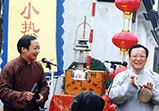
Xiaorehun
Xiaorehun is a kind of rap art performed on streets. It is known as "selling pear paste candy," or "Xiaoluoshu." Originated from “talking about dynasty news” on Hangzhou streets in the late Ding Dynasty, Xiaorehun is mainly popular in Hangzhou, Jiaxing, Huzhou, Jinhua, Ningbo and other areas. In 1905, Du Baolin used the form of “talking about dynasty news” to sell pear paste candy and developed news and life anecdotes into an interesting show that has a simple storyline, characters and conflicts, and performed it under the stage name of "Xiaorehun." It is performed in Hangzhou dialect and accompanied by a small gong or three small wooden sticks. The performance is funny and witty, with no fixed performance venue.
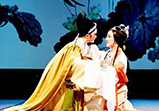
Hangzhou Opera
Also known as Wulinban, it is a local opera in Hangzhou, originating from Hangzhou Xuanjuan and popular in Hangzhou, Ningbo, Yixing, Changzhou, Wuxi and Zhenjiang. The singing and recitation of Hangzhou Opera are based on Hangzhou official dialect, and uses Zhongzhou rhyme. The tunes are languid and simple, rough and high. In 2009, with Hangzhou Comic Art Theatre and Hangzhou Huanglong Yueju Opera Troupe as the base, Hangzhou Opera Troupe and Huanglong Hangzhou Opera Troupe were restored and established. "New Dragon and Phoenix Lock," "Forever Leifeng" and other new plays have won many provincial and municipal awards.
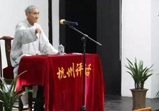
Hangzhou Storytelling
Also known as "Hangzhou Dashu," it is an art form popular in Hangzhou and the surrounding areas. It originated in the Southern Song Dynasty, and was gradually formed in the late Ming and early Qing Dynasties, and further developed in Daoguang and Xianfeng Periods of Qing Dynasty. The story is told by one person in Hangzhou dialect. In June 2008, Hangzhou Storytelling was approved by the State Council to be included in the second batch of national intangible cultural heritage list.
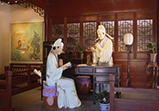
Hangzhou Tanhuang
Also known as "Ankang," it originated in Qianlong Period of Qing Dynasty. It is popular in Hangzhou and Yuhang, etc. The performance is based on Hangzhou dialect, sung in Zhongzhou rhyme, and the content is based on Kunqu Opera. There are five to seven people in a group, sitting and singing with their own instruments or with an orchestra. The repertoire can be divided into two categories: "Qiantan" and "Houtan." Hangzhou Tanhuang mainly uses the former one. In June 2008, it was approved as one of the first-batch national intangible cultural heritage list.
